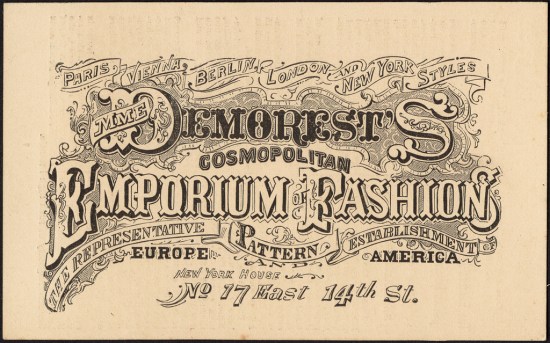(You might want to catch up: Part One, Part Two, Part Three.)
By the start of the 1900s, home sewing and clothing patterns were big business. One of the last to enter the fray at the turn of this century, would become another one of the big names in sewing pattern collecting. According to Zuelia Ann Hurt in Craft Tools — Then and Now (Decorating & Craft Ideas, October 1980 issue):
Soon after 1900 a prominent fashion magazine called Vogue published a coupon for a pattern. For fifty cents, the reader received a pattern hand-cut by the designer Mrs. Payne on her dining-room table.

While Vogue was using its publishing power to spawn a fashion pattern business, the other sewing pattern companies did not slow down. Here are some notable moments — and collectible names — in sewing pattern history.
In 1902, James McCall’s The Queen of Fashion magazine changed its name again and became McCall’s Magazine, widening the contents of the publication to other womanly pursuits and interests.
In 1910, Butterick continued their sewing pattern industry innovation by introducing the “deltor” — the first instructions printed on a sheet included inside the pattern’s envelope.
In 1914, the Vogue pattern department officially left the magazine to become Vogue Pattern Company. (This was in no small part due to the 1909 purchase of Vogue by Condé Nast.) Vogue patterns continued to be sold by mail until 1917, when B. Altman’s department store in New York City became the first store to stock their patterns. In May of 1920, Vogue Patterns launches the Vogue Pattern Book.

In 1920, there was another major change in the sewing pattern industry. This time it was McCall’s leading the way by moving from the perforated tissue patterns to printed ones. Eventually the others would follow suit. McCall’s would also begin working with designers like Lanvin, Mainbocher, Patou, and Schiaparelli.
An advertising salesman for fashion magazine Fashionable Dress, Joseph M. Shapiro, was shocked to find that something consisting mainly of tissue paper would cost $1. Via his connections, he found the way to produce — and profit from — a pattern which would sell for just 15 cents. The Simplicity Pattern Company was born in 1927 and Joseph’s son, James J. Shapiro, was its first president. With such a low price, Simplicity expanded quickly, including internationally.
In 1931, Vogue starts Couturier Line and introduces new large format envelopes.
In 1931, Simplicity began producing DuBarry patterns exclusively for F. W. Woolworth Company (through 1940).

In 1932, Condé Nast starts the Hollywood Pattern Company. Hollywood Patterns featured designs straight of film and usually had photos of Hollywood stars on the packaging as well. The Hollywood Pattern Company ceased pattern production a few years after the end of World War II.
Also in 1932, McCall’s would again push the envelope by, well, pushing the envelope — now full-color illustrations appeared on the covers of McCall’s pattern envelopes.
In 1933, Advance began manufacturing patterns sold exclusively at (and for) the J. C. Penney Company. Because of the J.C. Penny connection, Advance was able to secure a number of designers (including Edith Head and Anne Fogarty) as well as rights from Mattel for authentic Barbie fashion patterns. (The company was sold to Puritan Fashions in 1966.)
In 1946, Simplicity finally fully converts from perforated patterns to printed sewing patterns.

In 1949, Vogue added the Paris Original Models patterns from French Couturiers and was the only company authorized to duplicate these fantastic designs. Such deals with international designers would expand, including millinery designs in 1953 and International Designer Patterns in 1956.
In the 1950s, McCall’s patterns produces another designer line which included French couturier Hubert de Givenchy and Emilio Pucci.
In 1958, Vogue Patterns fully transitions from perforated to printed tissue patterns.
In the 1960s, McCall’s “New York Designers’ Collection Plus” featured designs from Pauline Trigere and Geoffrey Beene, among others.
Starting in 1960s and continuing through 1970s, Butterick produces the “Young Designer” series, featuring designs by Betsey Johnson, John Kloss, and Mary Quant.
In 1961, Butterick licensed the Vogue name and began to produce patterns under the Vogue name.
Images: Vogue Spring, 1916, via hampshire-estate-finds; vintage McCall’s printed pattern via misslacyg; Vintage Hollywood Sewing Pattern # 747 featuring Betty Grable, via ohiochestnutt; and Vogue Paris Original pattern by Nina Ricci via dalejeri.


































